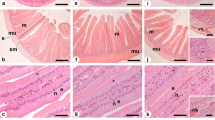Abstract
Rock doves (Columba livia) live-trapped in Blacksburg, Va. had the following blood characteristics measured: Delta aminolevulinic acid dehydratase (ALAD) activity, packed cell volume (PCV) and hemoglobin (Hb). Lead concentrations were measured in livers and femurs. Concentrations of lead in femurs were indicative of chronic exposure to lead in many individuals. A linear relationship was noted between ALAD activity and liver lead concentrations with ALAD decreasing with increased lead concentrations.
Similar content being viewed by others
References
Barr, A. J., J. H. Goodnight, J. P. Sall, and J. T. Helwig: A user's guide to SAS 76. Raleigh, NC: SAS Institute (1976).
Burch, H. B., and A. L. Siegel: Improved method for measurement of delta-aminolevulinic acid dehydratase activity of human erythrocytes. Clin. Chem.17, 1038 (1971).
Dieter, M. P., and M. T. Finley: Delta aminolevulinic acid dehydratase enzyme activity in blood, brain, and liver of lead-dosed ducks. Environ. Res.19, 127 (1979).
Dieter, M. P., M. C. Perry, and B. M. Mulhem: Lead and PCBs in canvasback ducks: Relationship between enzyme levels and residues in blood. Arch. Environ. Contam. Toxicol.5, 1 (1976).
Goldsmith, C. D., Jr., P. F. Scanlon, and W. R. Pirie: Lead concentrations in soil and vegetation associated with highways of different traffic densities. Bull. Environ. Contam. Toxicol.16, 66 (1976).
Kendall, R. J.: The toxicology of lead shot and environmental lead in avian species with special emphasis on the biological significance in mourning dove populations. Ph.D. Dissertation. Virginia Polytechnic Institute and State University, Blacksburg, VA (1980).
Luckey, T. D., and B. Venugopal: Heavy metal toxicity in mammals. New York: Plenum Press (1976).
Ohi, G., H. Seki, K. Akiyama, and H. Yagyu: The pigeon, a sensor of lead pollution. Bull. Environ. Contam. Toxicol.12, 92 (1974).
Scanlon, P. F., V. D. Stotts, R. G. Oderwald, T. J. Dietrick, and R. J. Kendall: Lead concentrations in livers of Maryland waterfowl with and without ingested lead shot present in gizzards. Bull. Environ. Contam. Toxicol.25, 855 (1980).
Siegfried, W. R., P. G. H. Frost, E. P. Redelinghuys, and R. P. Van Der Merwe: Lead concentrations in the bones of city and country doves. South African J. Sci.68, 229 (1972).
Steel, R. G. D., and J. H. Torrie: Principles and procedures in statistics. New York: McGraw-Hill (1960).
Stone, C. L., M. R. S. Fox, A. L. Jones, and K. R. Mahaffey: Delta-aminolevulinic acid dehydratase—a sensitive indicator of lead exposure in Japanese quail. Poultry Sci.56, 174 (1977).
Tansey, M. F., and R. P. Roth: Pigeons: A new role in air pollution. J. Air Pollut. Cont. Assoc.20, 307 (1970).
Vallee, B. L., and D. D. Ulmer: Biochemical effects of mercury, cadmium, and lead. Ann. Rev. Biochem.41, 91 (1972).
Author information
Authors and Affiliations
Rights and permissions
About this article
Cite this article
Kendall, R.J., Scanlon, P.F. Tissue lead concentrations and blood characteristics of rock doves from an urban setting in Virginia. Arch. Environ. Contam. Toxicol. 11, 265–268 (1982). https://doi.org/10.1007/BF01055201
Received:
Accepted:
Issue Date:
DOI: https://doi.org/10.1007/BF01055201




